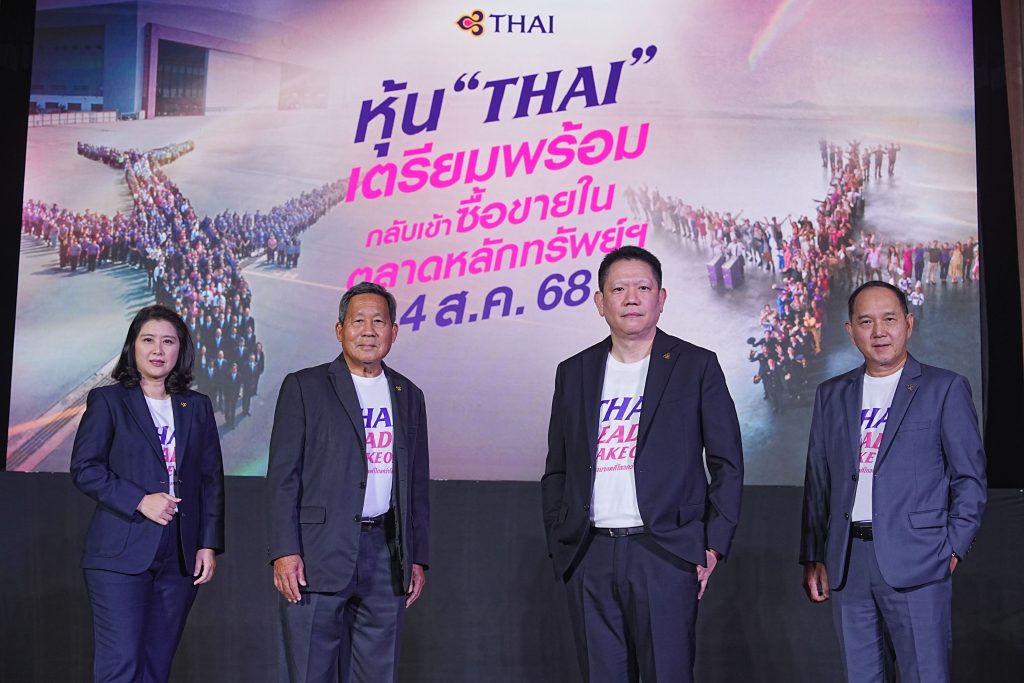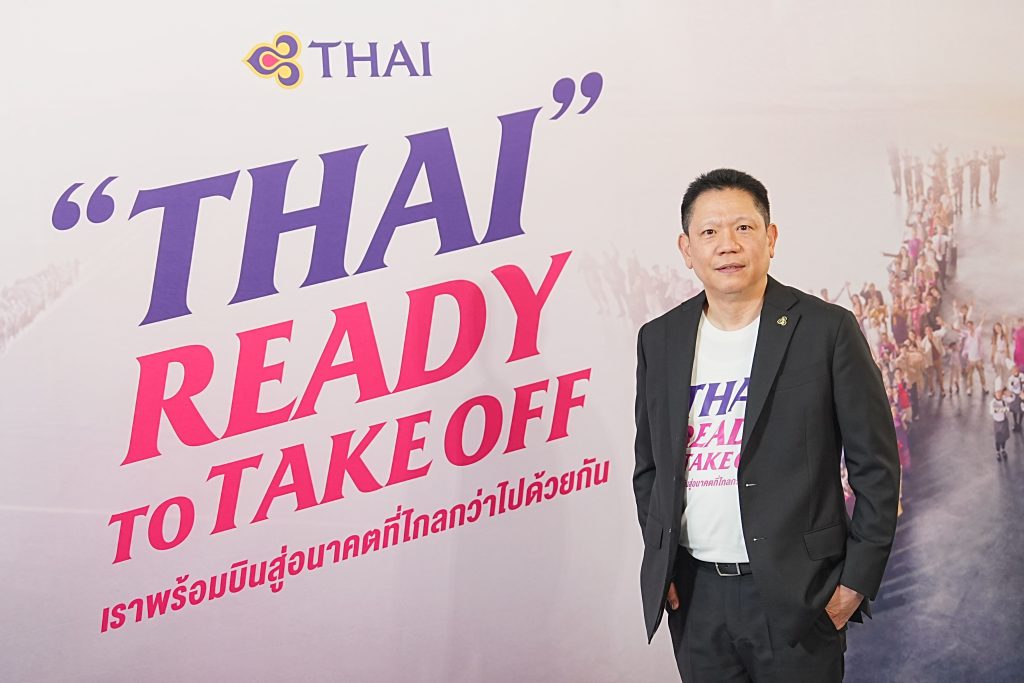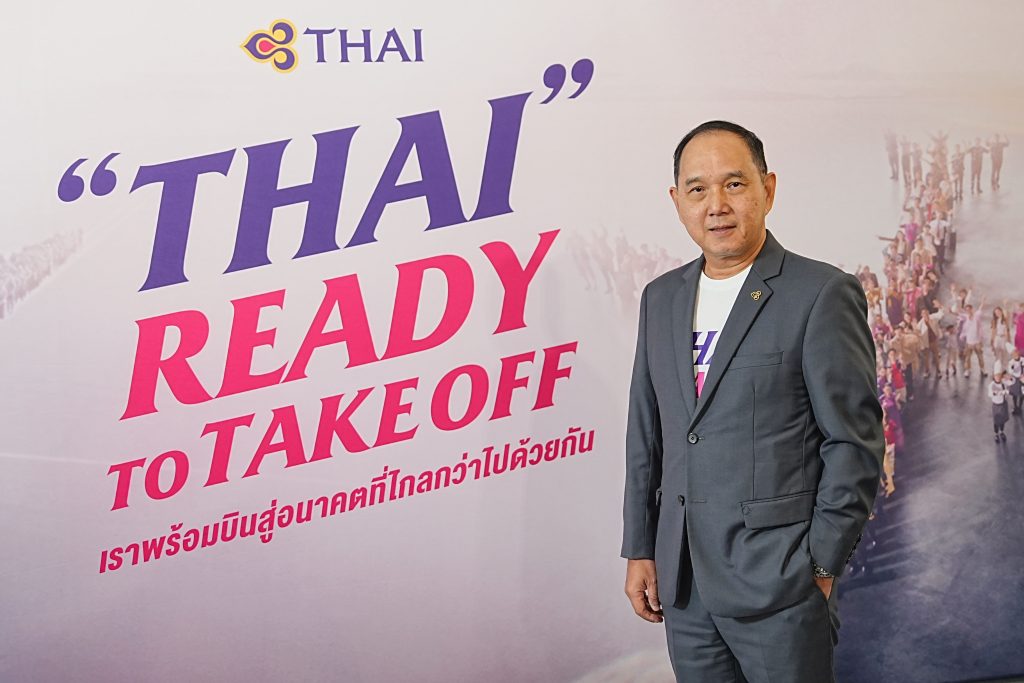After nearly five years, Thai Airways International Public Company Limited (THAI) has successfully completed its rehabilitation plan, having fulfilled all required conditions and received approval to return to the Thai stock market on August 4, 2025.
The Board of Directors has expressed confidence in Thai Airways’ financial and operational performance, highlighting a 21% year-on-year increase in Available Seat Kilometers (ASK) in 1Q25, with 78 aircraft in its fleet.
In the airline industry, ASK is a key benchmark that measures an airline’s capacity to generate revenue by quantifying the total number of kilometers flown by available seats.
With the support of professional rehabilitation planners, Thai Airways has fully revamped its organization to enhance efficiency and transparency. Despite a decline in employee numbers since the COVID-19 outbreak, the company has improved productivity, with ASK per employee rising from 2.54 pre-COVID to 3.01 in 1Q25.
According to the Department of Tourism, Chinese tourists ranked first among international arrivals to Thailand from January to May 2025, although the total number has shown signs of slowing. Nevertheless, over the past 12 months, Chinese tourists ranked only seventh in Thai Airways’ top-10 passenger revenue by country of destination—behind Japan, Australia, Germany, the UK, India, and Thai domestic travel. The Board emphasized that the decline in Chinese tourists had limited impact, as travelers from China contributed just 5% of total revenue.
Now operating at full capacity, Thai Airways plans to reclaim its lost market share in Thailand. Before COVID, the airline held a 20% share across all six international airports under Airports of Thailand PCL (SET: AOT), and 37% specifically at Suvarnabhumi Airport. However, due to the pandemic and an aging fleet, market share dropped to 15% for the six airports and 26% for Suvarnabhumi in 2024. The Board has set targets of 21% market share at the six airports and 35% at Suvarnabhumi by 2029.
For its 5-year (2025-29) CAPEX plan to support long-term growth of THB 160 billion, the Board added that Thai Airways has ample free cash flow to support its investment to 2027, which indicates strong financial status for the company.
Importantly, Mr. Lavaron Sangsnit, Chairman of the Board of Directors, stated that the Thai government will not increase its stake in Thai Airways beyond the current 36%, reaffirming that it is in the company’s best interest to remain a publicly listed firm rather than a state enterprise.

In its official statement, Thai Airways stated that the successful completion of the implementation under the business rehabilitation plan has transformed the airline into a private entity ready to instill confidence among shareholders and investors. With a track record of strong performance and a clear strategy for future growth, THAI is poised to reclaim its position as a leader in the regional aviation industry and a top-listed company on the stock exchange once again.

Mr. Lavaron Sangsnit, THAI Chairman of the Board of Directors, stated, ” The new Board of Directors is committed to steering THAI into a new era—one defined by operational excellence and robust corporate governance as a private company. I am confident that this board possesses the expertise and vision to propel the organization forward.
The Board’s composition strategically blends experience from both the public and private sectors. The 11-member Board includes three directors from the pre-rehabilitation period, two of whom also served as plan administrators. They are joined by eight new directors, appointed by shareholders following a rigorous board skills matrix review to ensure comprehensive expertise in aviation, finance, law, strategy, marketing, and digital technology. Dedicated sub-committees, including Audit Committee and Nomination and Remuneration Committee, will also provide comprehensive oversight. Furthermore, the board and management are aligned in a shared vision and are ready to work in close partnership. By retaining the core management team that led the rehabilitation, we ensure a seamless continuation of our successful strategy.
Today, THAI is positioned at its strongest point in all aspects, including financial health, operational efficiency, and competitive capability. The company has a clear and robust growth trajectory, supported by strategic initiatives that include an optimized organizational structure tailored to our business scale. Our personnel expenses are maintained at levels competitive with leading airlines of similar standing, while preserving flexibility to swiftly adapt to dynamic market conditions. Furthermore, we place great emphasis on full compliance with the regulations and guidelines of the Stock Exchange of Thailand and the Securities and Exchange Commission.
On the environmental front, as an airline operator, THAI is committed to minimizing the environmental impact of our operations, with a clear target to achieve net zero emissions by 2065. Our goal is to build upon the successes of our recent restructuring to establish a solid foundation for sustainable growth through transparency and strong corporate governance. This approach aims to foster long-term trust and confidence among our shareholders and all stakeholders.”
Dr. Piyasvasti Amranand, THAI Director and former Chairman of the Plan Administrator, added, “THAI successfully completed all conditions of its business rehabilitation plan in just four years since its plan was approved by the Central Bankruptcy Court in 2021. The success of this process is clearly reflected in our consistently outstanding operating results.
In 2024, the airline achieved an operating profit (before financial costs and excluding one-time items) of 41,515 million baht and has sustained that momentum. For the first quarter of 2025, we reported an operating profit (before financial costs and non-recurring items) of 13,661 million baht, resulting in an EBIT margin of 26.5%. This is the highest among full-service carriers in Asia-Pacific and Europe (source: Airline Weekly), demonstrating exceptional management efficiency. A key part of this new chapter is our new board of directors, appointed by shareholders, which comprises a team of seasoned experts with diverse experience who will steer the organization toward stable, sustainable, and transparent growth on a global scale. This marks the dawn of a new, stronger Thai Airways, poised for long-term success.”

Mr. Chai Eamsiri, THAI Chief Executive Officer, elaborated the company’s growth strategy, stating, “Our current growth trajectory is not just a rebound from the covid-19 pandemic, but is the result of a comprehensive restructuring effort and a clearly defined long-term strategy. This includes: (1) Restructuring and rightsizing the organizational structure to be more agile and efficient, while increasing transparency and accountability in all operational processes. (2) Executing a strategic fleet optimization with a target to have 150 aircrafts by 2033. By streamlining our fleet from eight aircraft models to just four, and our engine types from nine to five, we have significantly enhanced cost control in both operations and maintenance. With this lean foundation, we aim to reclaim our historical market share, targeting an increase from the current 26% to 35% by 2029. (3) Expanding routes and increasing flight frequencies to solidify our position as a regional network airline connecting Asia with the rest of the world. (4) Enhancing cabin services and sales channels to elevate the customer experience. (5) Integrating digital technology into all work processes to boost efficiency, including improving our website and application for user convenience and creating opportunities to increase the proportion of revenue from direct sales channels. These strategic pillars collectively position THAI for sustainable growth and give us a competitive edge to re-emerge as a formidable leader in the regional aviation industry.”
Mrs. Cherdchome Therdsteerasukdi, THAI Chief, Finance & Accounting, highlighted the company’s current financial strength, stating, “THAI now stands on a significantly stronger and more stable financial foundation as demonstrated by our consistent operational profitability. For fiscal year 2024, total revenues (excluding one-time items) reached 187,989 million baht, a 16.7% year-on-year increase. Operating profit before financial costs (excluding one-time items) stood at 41,515 million baht, yielding a strong EBIT margin of 22.1%. This positive trend continued into the first quarter of 2025 as total revenue (excluding one-time items) rose 12.3% year-on-year to 51,625 million baht, while operating profit (before financial costs and excluding non-recurring items) reached 13,661 million baht. Our key performance indicators remained robust, with a cabin factor of 83.3% and passenger yield at 2.91, reaching a similar level to the year prior.
Furthermore, we successfully converted 53,453 million baht of deferred creditor debt and interest into equity while raising an additional 22,987 million baht through a new share offering to existing shareholders and employees in 2024. These actions restored our financial health, turning shareholders’ equity from a negative 43,142 million baht at year-end 2020 to a positive 55,439 million baht as of March 31, 2025.
Consequently, our interest-bearing debt to equity (IBD/E) ratio fell to just 2.2 times, down from 12.5 times in 2019. Crucially, this was achieved without imposing any principal reduction on our financial and commercial creditors, who represent the majority of our creditors. Repayment schedules are also clearly defined in the business rehabilitation plan through 2036. This success is the result of hard work, strict financial discipline, and the cooperation of all creditors, THAI employees, and every stakeholder.”



